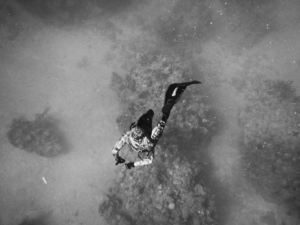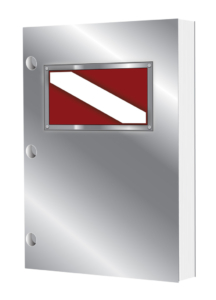Consisting of an angled white stripe against a red background, the dive flag has become an important icon among recreational and commercial divers alike. As shown above, it features a simple yet highly visible design that’s instantly recognizable. If a boat approaches an area in which a dive flag is deployed, the captain will know that a diver is present in the waters nearby. Even if you’re familiar with the basic design of the dive flag, though, you might be wondering how it was created. In this post, you’ll learn more about the history of the dive flag, including when it was created and who was responsible for the original design.
What Is the Dive Flag?
 Before “diving” into the history of the dive flag, let’s first take a look at its purpose. The dive flag is used to notify boat captains, as well as other divers, that someone is diving in the waters below. It’s typically attached to a buoy that floats on the surface. If you’re planning to dive, you can deploy a dive flag to create a safer diving environment. While boat-related injuries among divers are rare, they can and do occur.
Before “diving” into the history of the dive flag, let’s first take a look at its purpose. The dive flag is used to notify boat captains, as well as other divers, that someone is diving in the waters below. It’s typically attached to a buoy that floats on the surface. If you’re planning to dive, you can deploy a dive flag to create a safer diving environment. While boat-related injuries among divers are rare, they can and do occur.
A dive flag can lower your risk of injury by informing boat captains of your presence. Upon spotting the dive flag on the surface, boat captains will immediately know that you are diving below. As a result, they can adjust their course to avoid piloting their boat in your direction. Failure to use a dive flag, on the other hand, may leave you susceptible to boating-related injuries. If you happen to resurface directly over a passing a boat, the boat could strike and injure you.
Origins of the Dive Flag
The origins of the dive flag can be traced back to the early 1950s. Prior to this period, diving was a fairly dangerous activity due to the lack of regulations. There weren’t many laws governing diving, nor was there an official dive flag. Combined with questionable diving equipment — equipment that’s now obsolete by today’s standards — divers were a greater risk of injury. This all changed, however, thanks to U.S. Navy veteran Denzel James Dockery, who went by the nickname “Doc,” and his loyal wife, Ruth.
After being discharged from the U.S. Navy in 1949, Doc used the skills he learned while serving in the Navy to build a homemade diving rig. As a former sailor, Doc acknowledged the need for a universal dive flag. He was firsthand the dangers of piloting boats close to divers. This prompted Doc and Ruth to develop a flag that divers could deploy to notify nearby boats of their presence.
Doc recalled how the Navy used an all-red flag to signal danger. Doc didn’t want to use the same design for a dive flag, however, so he and Ruth began brainstorming new ideas. The couple’s first design consisted of a single horizontal white stripe running through the middle of a red background. Although they were initially happy with the design, they soon realized that it was Austria’s official flag. Dockery and Ruth then altered the design by running the white stripe vertically rather than horizontally. Unfortunately, the Navy was already using this design for a numerical signal flag.
With the couple’s two previous designs already on use, Doc and Ruth decided to use a diagonally oriented white stripe for their dive flag. The design was pretty much the same as their previous two designs. Rather than using a vertical or horizontal white stripe, though, Doc and Ruth used a diagonal white stripe, thus leading to the creation of the modern dive flag.
In the 1950s, Doc and Ruth opened a diving business in Flint, Michigan where they sold diving equipment, including their newly created dive flag. The couple also offered a safety course where they taught divers how to increase their visibility and protect against boat-related injuries. During this course, Doc and Ruth explained the importance of using a dive flag.
In 1956, Ted Nixon, a sales representative for U.S. Divers — one of the country’s largest vendors of diving equipment at the time — visited the Doc and Ruth’s shop in Flint, Michigan. Nixon was immediately impressed with the couple’s innovative product, so much in fact that he wanted to distribute it nationally. The couple happily agreed, resulting in widespread exposure for their dive flag. As news spread about the couple’s dive flag, diving magazines and organizations began to showcase the flag. It wasn’t long until the Doc and Ruth’s flag became universally recognized as “warning: divers nearby.”
Michigan Adopts the Dive Flag
 To further spread the word about their newly created dive flag, Doc and Ruth approached lawmakers in their home state of Michigan, asking them to adopt the design as the state’s official dive flag. With the help of his local dive club, the couple was successful in their efforts. Michigan then passed a law declaring the couple’s design as the state’s official dive flag. In 1962, a court case involving a diver who was injured from a boat strike cited the use of a dive flag. This was the first time Michigan — or any other state for that matter — recognized the dive flag in law.
To further spread the word about their newly created dive flag, Doc and Ruth approached lawmakers in their home state of Michigan, asking them to adopt the design as the state’s official dive flag. With the help of his local dive club, the couple was successful in their efforts. Michigan then passed a law declaring the couple’s design as the state’s official dive flag. In 1962, a court case involving a diver who was injured from a boat strike cited the use of a dive flag. This was the first time Michigan — or any other state for that matter — recognized the dive flag in law.
While Michigan was the first state to adopt Doc and Ruth’s design as the official dive flag, other states soon jumped on board. Today, nearly all U.S. states, as well as the federal government, recognize the couple’s design as the official dive flag. It’s even become recognized as the official flag for North America. Throughout most of North American, you’ll see the red-and-white design used as the dive flag.
How the Dive Flag Is Used Today
The dive flag is used primarily to indicate the presence of a diver or dive group in the waters nearby. Either before or immediately after entering the water, a diver will deploy a dive flag that floats on the surface. With its red and white design, dive flags are highly visible against the blue ocean waters. When a boat captain sees a dive flag floating on the surface, he or she pilot the boat in a different direction.
While the primary purpose of a dive flag is to signal the presence of a diver, they are used for other purposes. Dive shops, for example, often display the dive flag to attract customers. If you’re vacationing in an area unfamiliar area and see the dive flag displayed in front of a business, it’s safe to assume that business sells diving equipment and services. You’ll also see the dive flag displayed on dive logs and other equipment.
North American vs Alpha Dive Flag: What’s the Difference?
In North America, the official dive flag consists of a single white stripe that runs diagonally against a red background. With that said, territories outside of North America typically use a different dive flag. Known as the Alpha or Alfa dive flag, it features a white inward-pointing triangle on the right side against a blue background. Aside from its appearance, though, the Alfa dive flag serves the same purpose — it notifies boat captains of the presence of a diver.
Let your friends and family know of your diving habits with the Red Dive Flag Scuba Log Book.



